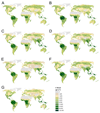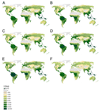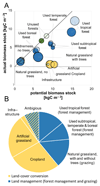Unexpectedly large impact of forest management and grazing on global vegetation biomass
- PMID: 29258288
- PMCID: PMC5756473
- DOI: 10.1038/nature25138
Unexpectedly large impact of forest management and grazing on global vegetation biomass
Abstract
Carbon stocks in vegetation have a key role in the climate system. However, the magnitude, patterns and uncertainties of carbon stocks and the effect of land use on the stocks remain poorly quantified. Here we show, using state-of-the-art datasets, that vegetation currently stores around 450 petagrams of carbon. In the hypothetical absence of land use, potential vegetation would store around 916 petagrams of carbon, under current climate conditions. This difference highlights the massive effect of land use on biomass stocks. Deforestation and other land-cover changes are responsible for 53-58% of the difference between current and potential biomass stocks. Land management effects (the biomass stock changes induced by land use within the same land cover) contribute 42-47%, but have been underestimated in the literature. Therefore, avoiding deforestation is necessary but not sufficient for mitigation of climate change. Our results imply that trade-offs exist between conserving carbon stocks on managed land and raising the contribution of biomass to raw material and energy supply for the mitigation of climate change. Efforts to raise biomass stocks are currently verifiable only in temperate forests, where their potential is limited. By contrast, large uncertainties hinder verification in the tropical forest, where the largest potential is located, pointing to challenges for the upcoming stocktaking exercises under the Paris agreement.
Conflict of interest statement
The authors declare no competing financial interest.
Figures








References
References for Extended Data
-
- Bazilevich NI, Rodin LY, Rozov NN. Geographical Aspects of Biological Productivity. Sov Geogr. 1971;12:293–317.
-
- Pan Y, Birdsey RA, Phillips OL, Jackson RB. The Structure, Distribution, and Biomass of the World’s Forests. Annu Rev Ecol Evol Syst. 2013;44:593–622.
-
- Prentice IC, Harrison SP, Bartlein PJ. Global vegetation and terrestrial carbon cycle changes after the last ice age. New Phytol. 2011;189:988–998. - PubMed
-
- Hurtt G, et al. Harmonization of land-use scenarios for the period 1500–2100: 600 years of global gridded annual land-use transitions, wood harvest, and resulting secondary lands. Clim Change. 2011;109:117–161.
-
- Whittaker RH, Likens GE. Primary production: the biosphere and man. Hum Ecol. 1973;1:357–369.
References
-
- Houghton RA. Balancing the Global Carbon Budget. Annual Review of Earth and Planetary Sciences. 2007;35:313–347.
-
- Saugier B, Roy J, Mooney HA. Estimations of Global Terrestrial Productivity: Converging toward a Single Number? In: Roy J, Saugier B, Mooney HA, editors. Terrestrial Global Productivity. Academic Press; 2001. pp. 543–557.
-
- Stocker TF, Qin D, Plattner G-K, Tignor M, Allen SK, Boschung J, Nauels A, Xia Y, Bex V, Midgley PM, editors. IPCC. Climate Change 2013: The Physical Science Basis. Contribution of Working Group I to the Fifth Assessment Report of the Intergovernmental Panel on Climate Change. Cambridge University Press; 2013.
-
- GTOS. Biomass. Food and Agriculture Organization of the United Nations; 2009.
Publication types
MeSH terms
Substances
Grants and funding
LinkOut - more resources
Full Text Sources
Other Literature Sources

